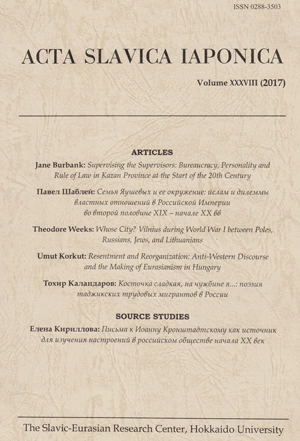Gerd Hentschel, Oleksandr Taranenko, and Sjarhej Zaprudski, eds., Trasjanka und Suržyk – gemischte weißrussisch-russische und ukrainischrussische Rede. Sprachlicher Inzest in Weißrussland und der Ukraine? (Frankfurt am Main: Peter Lang, 2014), 394 pp
Gerd Hentschel, Oleksandr Taranenko, and Sjarhej Zaprudski, eds., Trasjanka und Suržyk – gemischte weißrussisch-russische und ukrainischrussische Rede. Sprachlicher Inzest in Weißrussland und der Ukraine? (Frankfurt am Main: Peter Lang, 2014), 394 pp
Author(s): Dieter SternSubject(s): Language studies, Review, Sociolinguistics, Philology
Published by: Slavic Research Center
Summary/Abstract: It took quite some time for Trasianka and Surzhyk to find their way into Slavic studies as a subject in their own right. Obviously, the prevalent conservative academic climate before the demise of the Soviet Union was not auspicious for any studies of language beyond the beaten track of norm-enforcing structural linguistics. Gerd Hentschel, one of the editors of the present volume, was among the very first to undertake to make one of the mixed varieties, which form the topic of this volume, viz. Trasianka, the object of linguistic description based on field recordings. Preparatory to his five-year research project “Die Trasjanka in Weißrussland” [Trasianka in Belarus], funded by the Volkswagen Foundation, Hentschel organized in 2007 a conference on the topic “Studies on Belarusian Trasianka and Ukrainian Suržyk as a result of Belarusian- and Ukrainian-Russian language contact.” It took seven years to compile the proceedings of this conference and have the 18 contributions (six of them in English and the rest in German) published in the present volume. This, of course, raises the question of the publications being possibly outdated by now, the more so that in fact Trasianka and Surzhyk have seen a general upsurge in academic interest in recent years, which is reflected in a large number of publications. Some of the contributors appear, however, to have taken the trouble of updating their contributions in the long period that had elapsed since the conference, as shown by the general reference section at the end of the volume, which includes publications up to the year 2013 (not all of which appear to have been quoted, however, in the articles). In some cases, statements of individual contributions have been updated and revised by means of footnotes added by the editors. Notwithstanding these visible efforts to keep up with the evolution of the field, there is one adverse effect of severely delayed publication in this particular case, which cannot be hoped to be remedied by any efforts whatsoever. The conference took place at a date when most scholars were still in a state of finding their way through and coming to grips with what they were actually dealing with, and it must be added that many could have scored better if they were methodologically better equipped from the beginning. Neither a clear-cut phenomenology nor a sound method of how to approach both Surzhyk and Trasianka empirically had then been worked out. With few exceptions, most papers sum up the first groping advances on the topic, which abound with preliminary assessments of the linguistic situation and how it should be properly addressed. This causes many redundancies within the volume with many basic facts and competing assumptions about Surzhyk and Trasianka being repeated over and over again. Sound scholarly intuition and anecdotic observation still take the place of thorough empirical investigation. Seven years later, Surzhykology and Trasiankology has taken its first steps into large-scale empirical research, which, though empirical analysis in this field is still in its infancy, has taken the field definitely beyond what the present volume has to offer.
Journal: Acta Slavica Iaponica
- Issue Year: 2017
- Issue No: 38
- Page Range: 133-144
- Page Count: 12
- Language: English

